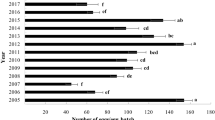Abstract
Lepidiota mansueta Burmeister (Coleoptera: Scarabaeidae) is a major pest of field crops at Majuli river island, Assam, India. Sampling carried out covering ten endemic villages for three successive years (2017–2019) revealed that the larval population of L. mansueta larvae remained the sameunder both pre and post-flood situations, indicating that submergence conditions had no detrimental effect on its population. In a confirmation trial based on a simulation model, it was further recorded that mortality was highly correlated (r2 = 0.846, P < 0.001) with duration of inundation with maximum mortality occurring only at 21 days (44%) and 28 days (60%) post inundated conditions. Further, scanning light microscopy and electron microscope sections showed cuticular modifications for spiracular respiration which lacks a closing aperture. The grub had peripneustic respiratory system with 9 pairs of functional spiracles. The absence of a conventional spiracular opening but the presence of a convex projecting central bulla in place of the opening, a sclerotized and smooth sieve plate with ultramicroscopic aeropyles might provide protection against entry of water into the tracheoles, allowing only gaseous exchange. Perhaps, the surface tension of the film of water over the sieve plate also prevents the flow of water into the tracheae.






Similar content being viewed by others
References
Allsopp PG (1989) Two new species of Lepidiota Kirby (Coleoptera: Scarabaeidae: Melolonthinae) from Australia with notes on L. noxia Britton. J Austral Entomol Soc 28:39–43
Bhattacharyya B, Pujari D, Bhuyan U, Handique G, Baruah AALH, Dutta SK, Tanaka S (2015) Seasonal life cycle and biology of lepidiota mansueta (Coleoptera: Scarabaeidae): a serious root-feeding pest in India. Appl Entomol Zool 50:435–442. https://doi.org/10.1007/s13355-015-0349-4
Cherry RH (1984) Flooding to control the grub Ligyrus subtropicus (Coleoptera: Scarabaeidae) in Florida sugarcane. J Econ Entomol 77:254–257. https://doi.org/10.1093/jee/77.1.254
Cherry RH, Porter PS (1992) Respiration and behavior of a sugarcane grub, Ligyrus Subtropicus (Coleoptera: Scarabaeidae) under flooded conditions. J Entomol Sci 27:71–77
Fitzpatrick SM (2007) Survival of submerged larvae of cranberry girdler, Chrysoteuchia topiaria, in the laboratory. Crop Prot 26:1810–1816. http://www.jstor.org/stable/44491475
Galbreath RA (1976) Spiracle structure and function in Costelytra zealandica larvae (Coleoptera: Scarabaeidae). New Z J Zool 3:333–337
Gaugler R, Campbell JF (1991) Selection for enhanced host-finding of scarab larvae (Coleoptera: Scarabaeidae) in an entomopathogenic nematode. Environ Entomol 20:700–706
Hebets EA, Chapman RF (2000) Surviving the flood: plastron respiration in the non-tracheate arthropod Phrynus marginemaculatus (Amblypygi: Arachnida). J Insect Physiol 46:13–19. https://doi.org/10.1016/s0022-1910(99)00096-7
Hinton HE (1967) Structure and ecdysial process of the larval spiracles of the Scarabaeoidea, with special reference to those of Lepidoderma. Austral J Zool 15:947–953
Howden HF (1982) Larval and adult characters of Frickius Germain, its relationship to the Geotrupini, and a phytogeny of some major taxa in the Scarabaeoidea (Insecta: Coleoptera). Can J Zool 60:2713–2724. https://doi.org/10.1139/z82-347
Jameson ML, Moron M (2001) Descriptions of the larvae of Chlorota cincticollis Blanchard and Chasmodia collaris (Blanchard) (Scarabaeidae: Rutelinae: Rutelini) with a key to the larvaeof the american Genera of Rutelini. Coleop Bull 55:385–396. https://doi.org/10.1649/0010-065X(2001)055[0385:DOTLOC]2.0.CO;2
Kotoky P, Bezbaruah D, Baruah J, Sarma JN (2003) Erosion activity on Majuli-the largest river island of the world. Curr Sci 84:929–932
Krivosheina MG (2005) The plastron is a universal structure that ensures breathing of dipteran larvae both in the water and in the air. Doklady Biol Sci 401:112–115
Kuniata LS, Young GR (1992) The biology of Lepidiota reuleauxi Brenske (Coleoptera: Scarabaeidae), a pest of sugarcane in Papua New Guinea. J Austral Entomol Soc 31:339–343. https://doi.org/10.1111/j.1440-6055.1992.tb00521.x
Mcquillan PB (1985) The identification of root-feeding cockchafer larvae (Coleoptera: Scarabaeidae) found in pastures in Tasmania. Austral J Zool 33:509–546. https://doi.org/10.1071/ZO9850509
Sarma JN, Phukan M (2004) Origin and some geomorphological changes of Majuli Island of the Brahmaputra River in Assam, India. Geomorphol 60:1–19. https://doi.org/10.1016/j.geomorph.2003.07.013
Summers TE (1977) Flooding for the control of the white grub, Bothynus subtropicus in Florida. Am Soc Sugarcane Technol 7:128
Theurkar SV, Ghadage MK, Patil SB (2013) New laboratory culture method for white grub national pest, India. Int Res J Biol Sci 2:83–85
Woodman JD (2015) Surviving a flood: effects of inundation period, temperature and embryonic development stage in locust eggs. Bull Entomol Res 105:441–447. https://doi.org/10.1017/S0007485315000243
Zorn MI, Van Gestel CAM, Morrien E, Wagenaar M, Eijsackers H (2008) Flooding responses of three earthworm species, Allolobophora chlorotica, Aporrectodea caliginosa and Lumbricus rubellus, in a laboratory-controlled environment. Soil Biol Biochem 40:587–593. https://doi.org/10.1016/j.soilbio.2007.06.028
Acknowledgements
The authors extend their gratitude to ICAR- All India Network Project on Soil Arthropod Pests, Rajasthan Agricultural Research Institute, Durgapura, Rajasthan, India for providing necessary funds for conducting the research.
Author information
Authors and Affiliations
Corresponding author
Ethics declarations
Conflict of interest
On behalf of all authors, the corresponding author states that there is no conflict of interest regarding the manuscript.
Additional information
Publisher’s Note
Springer Nature remains neutral with regard to jurisdictional claims in published maps and institutional affiliations.
Rights and permissions
Springer Nature or its licensor (e.g. a society or other partner) holds exclusive rights to this article under a publishing agreement with the author(s) or other rightsholder(s); author self-archiving of the accepted manuscript version of this article is solely governed by the terms of such publishing agreement and applicable law.
About this article
Cite this article
Bhattacharyya, B., Handique, G., Borkataki, S. et al. Surviving submergence in larval stage: a strategy of Lepidiota mansueta Burmeister (Coleoptera: Scarabaeidae) living on flood plains of Majuli river island. Int J Trop Insect Sci 43, 719–726 (2023). https://doi.org/10.1007/s42690-023-00978-9
Received:
Accepted:
Published:
Issue Date:
DOI: https://doi.org/10.1007/s42690-023-00978-9



